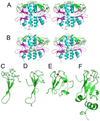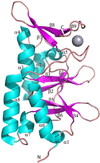Biochemical and structural characterization of a novel family of cystathionine beta-synthase domain proteins fused to a Zn ribbon-like domain
- PMID: 18021800
- PMCID: PMC2613313
- DOI: 10.1016/j.jmb.2007.10.060
Biochemical and structural characterization of a novel family of cystathionine beta-synthase domain proteins fused to a Zn ribbon-like domain
Abstract
We have identified a novel family of proteins, in which the N-terminal cystathionine beta-synthase (CBS) domain is fused to the C-terminal Zn ribbon domain. Four proteins were overexpressed in Escherichia coli and purified: TA0289 from Thermoplasma acidophilum, TV1335 from Thermoplasma volcanium, PF1953 from Pyrococcus furiosus, and PH0267 from Pyrococcus horikoshii. The purified proteins had a red/purple color in solution and an absorption spectrum typical of rubredoxins (Rds). Metal analysis of purified proteins revealed the presence of several metals, with iron and zinc being the most abundant metals (2-67% of iron and 12-74% of zinc). Crystal structures of both mercury- and iron-bound TA0289 (1.5-2.0 A resolution) revealed a dimeric protein whose intersubunit contacts are formed exclusively by the alpha-helices of two cystathionine beta-synthase subdomains, whereas the C-terminal domain has a classical Zn ribbon planar architecture. All proteins were reversibly reduced by chemical reductants (ascorbate or dithionite) or by the general Rd reductase NorW from E. coli in the presence of NADH. Reduced TA0289 was found to be capable of transferring electrons to cytochrome C from horse heart. Likewise, the purified Zn ribbon protein KTI11 from Saccharomyces cerevisiae had a purple color in solution and an Rd-like absorption spectrum, contained both iron and zinc, and was reduced by the Rd reductase NorW from E. coli. Thus, recombinant Zn ribbon domains from archaea and yeast demonstrate an Rd-like electron carrier activity in vitro. We suggest that, in vivo, some Zn ribbon domains might also bind iron and therefore possess an electron carrier activity, adding another physiological role to this large family of important proteins.
Figures









References
-
- Bateman A. The structure of a domain common to archaebacteria and the homocystinuria disease protein. Trends Biochem Sci. 1997;22:12–13. - PubMed
-
- Ignoul S, Eggermont J. CBS domains: structure, function, and pathology in human proteins. Am J Physiol Cell Physiol. 2005;289:C1369–C1378. - PubMed
-
- Bennetts B, Rychkov GY, Ng HL, Morton CJ, Stapleton D, Parker MW, Cromer BA. Cytoplasmic ATP-sensing domains regulate gating of skeletal muscle ClC-1 chloride channels. J Biol Chem. 2005;280:32452–32458. - PubMed
Publication types
MeSH terms
Substances
Associated data
- Actions
- Actions
Grants and funding
LinkOut - more resources
Full Text Sources
Molecular Biology Databases
Miscellaneous

